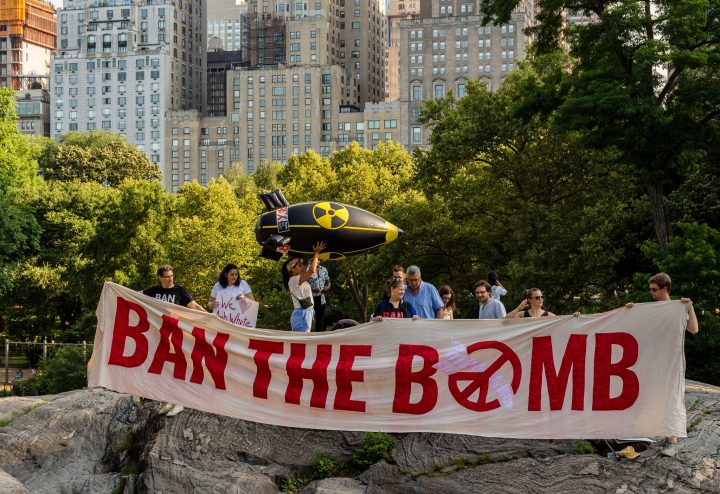Last week I had the great pleasure to interview Beatrice Fihn from the International Campaign to Abolish Nuclear Weapons, and towards the end of that interview Beatrice said quite matter-of-factly that no one would ever consider building bridges to Nazism and create a consensus in which it’s ok to be a little bit Nazi, so why would we try to build bridges to those who would keep the world armed with nuclear weapons?
I think Beatrice was quite shocked by how forthright and strong her statement sounded given her subsequent comment on twitter.
Disclaimer: I don’t think people that object to the ban are nazis. I got a bit carried away there ?
— Beatrice Fihn (@BeaFihn) 8 September 2017
In our world today, to denounce someone as a Nazi is almost the worst thing you can say, comparable to using the “N” word against someone of black African heritage: a word so strong it can’t even be written. Yet, if we look deeper into what she’s saying we can find that actually the comparison is quite right and can be justified.
The accusation of Nazism comes with all the connotations that in fact the Nazis were not only responsible for the Holocaust, the evil and scale of which are incomprehensible, but also for the Second World War as a whole which, in total, accounted for fatalities in the order of 60 million people, or an estimated 3% of the global population.
This kind of mass-murder on an industrial-scale seems unthinkable today. And yet, those who promote nuclear weapons as a useful tool for peace and security are blind to the incoherence of their arguments.
The most authoritative piece of work done on the humanitarian consequences of nuclear weapons was undertaken by the International Physicians for the Prevention of Nuclear War, in their report “Nuclear Famine: two billion people at risk” prepared by Dr. Ira Hefland in November 2013.
Let’s review once more the most salient points of that study.
In a limited nuclear war between India and Pakistan in which 50 bombs were dropped by each side, sufficient smoke and dust would be ejected into the atmosphere to cause a nuclear winter in which:
- US corn production would drop by 10% on average for a decade. Soybeans would be similarly affected.
- Chinese middle-season rice production would drop by, on average, 21% over four years and then improve to a 10% drop for a further 6 years.
- Chinese winter wheat production would drop by an average of 31% over ten years.
- The numbers of malnourished people in the world would rise by 215 million, added to the 870 million already malnourished and living on less than 1750 calories per day.
- In addition 1 billion people in China would face the prospect of famine
This total of over 2 billion people at risk of famine (about 25% of global population to compare it to WW2) has to be added to the fact that the world will simply stop functioning as it does today. Global trade would virtually stop and global confidence would cease to exist: no one would buy stocks and shares. No one would buy gold. Food and medicines would be the new currency. Local wars and large scale violence would flourish. Nuclear power stations affected by the war would melt down and explode, ejecting their radioactive poison into the atmosphere. Human civilisation in the way we currently understand it would come to a halt.
The data that went into this report has been presented in conference after conference over the last 5 years, and to my knowledge, no one has ever refuted it or tried to minimise it.
It is information such as this that led, this year, to the creation of a Treaty on the Prohibition of Nuclear Weapons which opens for signature on the 20th of September during the UN General Assembly gatherings.
Even from the moment of its approval, diplomats from the USA, France and the UK rushed to tell the world’s media, “We do not intend to sign, ratify or ever become party to it.”
They added, “Accession to the ban treaty is incompatible with the policy of nuclear deterrence, which has been essential to keeping the peace in Europe and North Asia for over 70 years.”
So what is this nuclear deterrence argument of which they speak? Let’s look into this.
The most compelling argument against nuclear deterrence was written by US author, Ward Wilson, in his excellent book, “Five Myths about Nuclear Weapons”. In it he systematically destroys, not only the myth that the Hiroshima and Nagasaki bombs were what led Japan to surrender at the end of World War II, but he also shreds the arguments used to support nuclear deterrence.
Just ask yourself, how did deterrence stop the USSR stationing bombs in Cuba? The Korean War, the Vietnam War, the Iraq War and the Falklands War; none of these wars were prevented by one side or both possessing nuclear weapons.
The dogmatic repetition by nuclear-armed states of “nuclear deterrence” has more to do with their own feelings of self-importance at their ability to destroy the planet, than a real consideration for the security of their own citizens.
So, as the Ban Treaty opens for signature, it is incumbent on all of us who oppose nuclear weapons to be able to point out these facts, and when we encounter those who would keep nuclear weapons, we have to ask them in which scenario they will use nuclear weapons?
Because, one nuclear weapon dropped on New York, London, Paris, Moscow, Beijing, Mumbai or Karachi would be enough to kill 6 million people. And if this kind of statistic doesn’t warrant comparison with Nazism, then nothing does.










